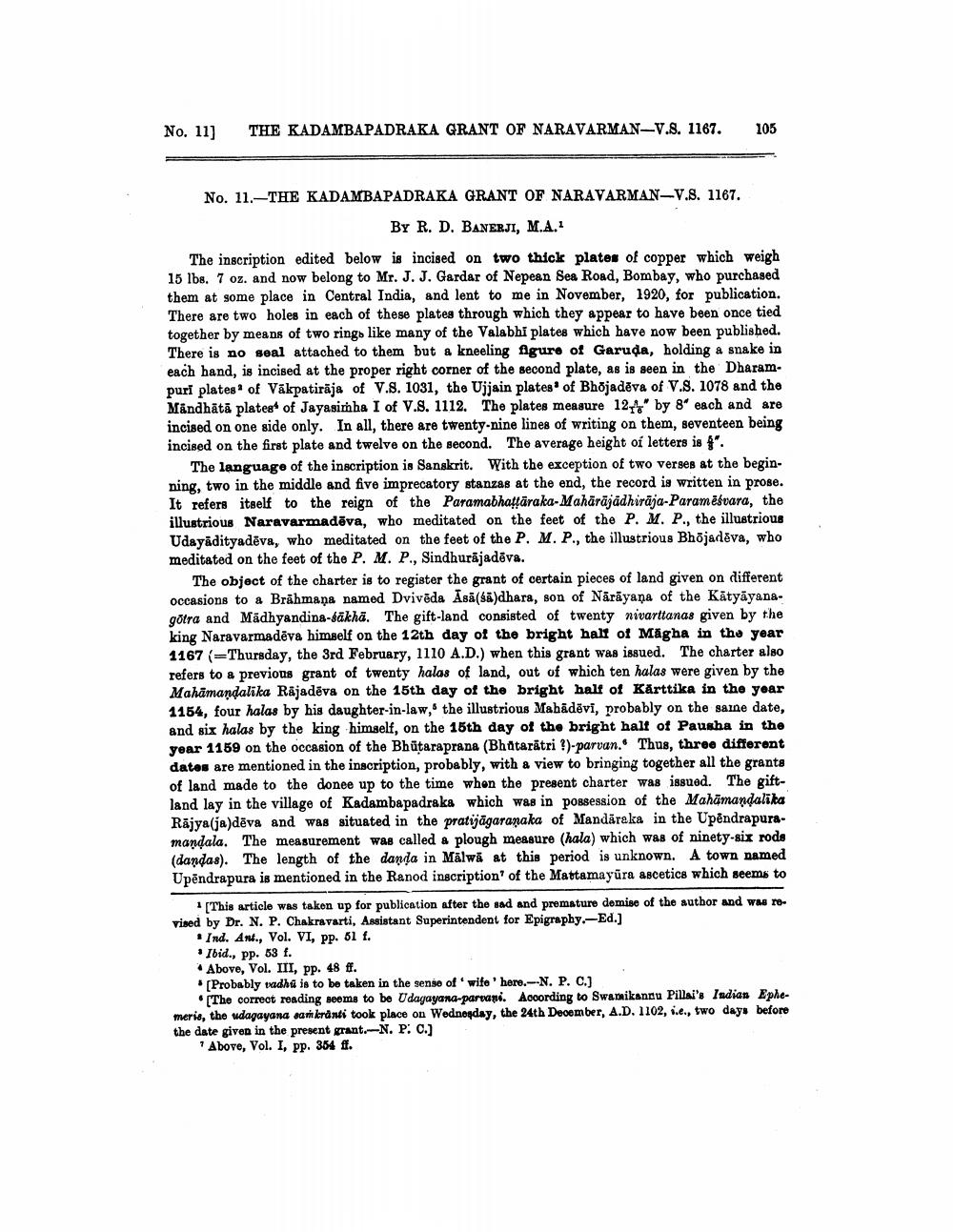________________
No. 11]
THE KADAMBAPADRAKA GRANT OF NARAVARMAN-V.8. 1167.
105
No. 11.-THE KADAMBAPADRAKA GRANT OF NARAVARMAN-V.8. 1167.
BY R. D. BANERJI, M.A.The inscription edited below is incised on two thick plates of copper which weigh 15 lbs. 7 oz. and now belong to Mr. J. J. Gardar of Nepean Sea Road, Bombay, who purchased them at some place in Central India, and lent to me in November, 1920, for publication. There are two holes in each of these plates through which they appear to have been once tied together by means of two rings like many of the Valabhi plates which have now been published. There is no seal attached to them but a kneeling figure of Garuda, holding a snake in each hand, is incised at the proper right corner of the second plate, as is seen in the Dharampuri plates of Vākpatirāja of V.S. 1031, the Ujjain plates of Bhojadēva of V.S. 1078 and the Mändhātā platest of Jayasimha I of V.8. 1112. The plates measure 124" by 8each and are incised on one side only. In all, there are twenty-nine lines of writing on them, seventeen being incised on the first plate and twelve on the second. The average height oí letters is f".
The language of the inscription is Sanskrit. With the exception of two verses at the beginning, two in the middle and five imprecatory stanzas at the end, the record is written in prose. It refers itself to the reign of the Paramabhattāraka-Mahārājādhiraja-Paramēsvara, the illustrious Naravarmadēva, who meditated on the feet of the P. M. P., the illustrious Udayadityadēva, who meditated on the feet of the P. M. P., the illustrious Bhöjadeva, who meditated on the feet of the P. M. P., Sindhurajadēva.
The object of the charter is to register the grant of certain pieces of land given on different occasions to a Brāhmaṇa named Dvivēda Asā(sa)dhara, son of Nārāyana of the Kātyāyanagötra and Mädhyandina-läkha. The gift-land consisted of twenty nivarttanas given by the king Naravarmadēva himself on the 12th day of the bright half of Mägha in the year 1167 (=Thursday, the 3rd February, 1110 A.D.) when this grant was issued. The charter also refers to a previous grant of twenty halas of land, out of which ten halas were given by the Mahamandalika Rajadēva on the 15th day of the bright half of Kärttika in the year 1154, four halas by his daughter-in-law, the illustrious Mabädēvi, probably on the same date, and six halas by the king himself, on the 15th day of the bright halt of Pausha in the year 1159 on the occasion of the Bhūtaraprana (Bhatarātri ?)-parvan.. Thus, three different dates are mentioned in the inscription, probably, with a view to bringing together all the grants of land made to the donee up to the time when the present charter was issued. The giftland lay in the village of Kadambapadraka which was in possession of the Mahamandalika Rājya(ja)dēva and was situated in the pratijāgaranaka of Mandāraka in the Upendrapuramandala. The measurement was called a plough measure (hala) which was of ninety-six rode (dandas). The length of the danda in Malwa at this period is unknown. A town named Upēndrapura is mentioned in the Ranod inscription of the Mattamayūra ascetics which seems to
[This article was taken up for publication after the sad and premature demise of the author and was revised by Dr. N. P. Chakravarti, Assistant Superintendent for Epigraphy.-Ed.]
• Ind. Ant., Vol. VI, pp. 61 f.
Ibid., pp. 63 f. Above, Vol. III, pp. 48 ff. [Probably vadha is to be taken in the sense of wife' here.- N. P. C.)
• The correot reading seems to be Udayayana-parvari. According to Swamikannu Pillai's Indian Ephemeris, the wdagayana sankranti took place on Wednesday, the 24th December, A.D. 1102, i.e., two days before the date given in the present grant.-N. P. C.)
Above, Vol. I, pp. 364 ff.




